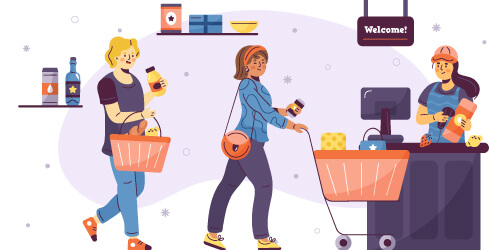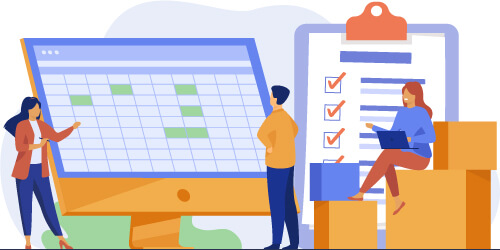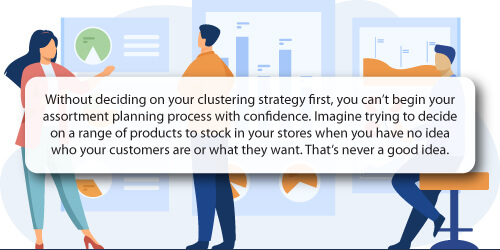There are many benefits to grouping similar stores and categories. For one, you can meet the needs of your customers. Another advantage is that you can foster a reputation as a go-to retailer for a specific range of products. And then, of course, there is the point that you can increase your retail sales.
That all speaks to the why you should implement clustering in your retail business. But what about the ‘what’. What retail clustering approach should you take? And also unpack the ‘how’? How can efficient clustering drive retail sales? We unpack it all below.

Which retail clustering approach should you choose?
When talk turns to retail clustering, it will also invariably turn to the question of how.
How should you approach clustering?
Fortunately, the answer to that question is straightforward. You can either take a category-based approach or a store-based approach.
You can read more about each method in more detail in our infographic here.
That said, there is a far more critical question worth asking than the one about the available options. It's this: between the two clustering methods, which is best? Put differently, which clustering method has the better chance of helping you to increase your retail sales?
Again, it's an easy question to answer. The best option available is category-based clustering.
Here's why:
If you define clustering as grouping stores based on similarities, doing it at a category level allows for a more meticulous and detailed approach. Since no two categories are the same, you shouldn't give each the same role.
Following such an approach also allows you to adapt to your immediate surroundings more efficiently. For example, if there is a Destination category nappy shop nearby your store, you could downsize this category and stock a core range instead of a Destination range.

How can efficient retail clustering drive retail sales?
Using the clustering method that works best for your stores means that you have every opportunity of pleasing your customers and, as a result, increase your retail sales.
For the sake of this piece, we’re looking exclusively at how category-based clustering can drive sales.
Below are just four ways in which it can do that.
1. You can cater to your target market more effectively
If you want to establish a reputation as a retail business known for pleasing shoppers, you can’t look past the importance of completing a category-based clustering exercise.
As already mentioned, it’s because it allows you to take an in-depth look at the needs and wants of your customer at a category level. But what does that mean exactly?
Here’s an example to explain further.
Let’s say you are a pharmacy retailer with two stores, each in a different location. That likely means you have two target markets to which you need to cater. Now let’s look at a category you’d find in each store - Hair Care.

After looking at the retail data gathered from Store / Category Grouping A, you discover many are shoppers buying Ethnic hair care products regularly. It’s one of your top sellers within the category. Meanwhile, your Caucasian hair care products appear to be poor sellers. You would thus want to open up on your Ethnic hair care products to meet your shoppers’ needs and reduce your Caucasian products range.
In Store / Category Grouping B, it’s the opposite. More shoppers are purchasing Hair Conditioners and Hair Oil suited for Caucasian hair than weaves, braids and relaxer kits. It would thus make sense to open up on your Caucasian hair care products for this store.
By the way, that’s not to say that you should stop ranging those products that are not top sellers in either store. You should still carry Caucasian hair products in Store A and include an Ethnic hair care section in Store B. In both cases, you must be mindful of the size of your range and adjust accordingly.
After all, better-suited ranges will increase your sales since your stores will appeal to the needs and wants of residents living in the immediate surroundings.
2. You can build planograms that service multiple stores
Once you have decided on your store clusters, the range you want to stock, and its depth, it’s time to build your data-driven planograms.
By clustering your stores according to product grouping, you’re saving yourself time and money. That’s the time and money you would usually spend on employing a handful of space planners to build all of your planograms in the first place.
There is also the point that by deciding your clusters and range first, you can produce a planogram for multiple stores at a time. And this is where it gets interesting. By building one planogram for multiple stores, you’ll ensure that the category layout appears consistent for each.
We’ll focus on uniformity and familiarity in more depth later in this piece. For now, it’s worth pointing out that familiarity leads to more sales. That’s because when a shopper is at ease and knows what to expect before they walk into a store, they’re likely to spend more.
By using a carefully crafted data-driven planogram that provides consistency across all your stores, shoppers will feel more inclined to increase their basket size. It also raises the possibility of impulse buying.
If you’re looking for category management software to help you build planograms, it's best to use software with a store communications capability.
Once you've created your planograms, such a tool would allow you to implement them effectively across all stores. It will also enable your Head Office to communicate clearly with each store manager about how and where to position your products in all stores.
3. You can reduce unnecessary stock holdings
The third reason to ensure you complete a store clustering exercise is that it leads to the reduction of unnecessary stock holdings as you have better control over a consistent range across stores. Again, the result of reducing excess stock is more sales.
That’s because by stocking the right products - essentially optimising your shelf for peak performance - you improve your chances of making more sales. More than that, you create localised assortments unique to a group of stores, which allows shoppers to identify with the respective stores based on their tastes and preferences.
To ensure you get this right, you need to have a firm grasp of your retail data and check it regularly. A monthly update will allow you to monitor any progress. A weekly check-up might work just as well, but be careful not to overanalyse your data.

You might notice a decrease or increase in sales for a particular product. But you shouldn’t immediately give more or less space to this specific product. Rather wait and monitor what happens. In the meantime, watch your other products within your category.
When a tipping point does arrive, and you want to derange that product that isn’t selling as well as in the past, you can replace it with another product that deserves more space on your shelf.
On the other hand, the longer you keep a poor-performing product on the shelf, the higher the chance of losing sales. One of the last things you’d want to face is the reality that you have too much stock that isn’t selling. That tells you that you don’t understand your target market, and thus you’re not meeting their needs.
4. You can create uniformity and familiarity for shoppers
Familiarity is vital in retail. We’ve touched on this point in a piece on what makes a retail store opening a success. In that article, we mention the importance of meeting customer expectations. They prefer familiarity over confusion.
It’s the same with clustering. By grouping your stores by the same characteristics, be that by LSM, size, store format or demographics to form a cluster, you can standardise your store layout. More importantly, you can create consistency across all of your stores.
This consistency has another benefit - it allows you to build stronger relationships with your customers.
Creating a shopping experience that customers want to experience again is what DotActiv is known for. If you’re looking for a solution that’ll help achieve that while improving your bottom line, talk to us today to find out how we can help you.
Of course, this uniformity shouldn’t stop at your store layout. To be truly useful, it needs to filter into every aspect of your retail business, including your store brand and product range.
For example, you’d want to ensure that stores in Cluster Grouping A - located in shopping malls - carry the same ranges to meet customer expectations. Thus, regardless of the location of the shopping mall, whenever a customer walks into one of these stores, they know what to expect.
You would ensure the same happens for all your stores located in small towns or rural areas.
The product range must meet the expectations of the customers who shop there regularly. That’s not to say that there won’t be anomalies, such as when a shopper who doesn’t fit the exact target market shops there.
In that case, to prevent any dissatisfaction on their part, you could look at including a core range of a particular product within the category.

Conclusion
Efficient retail clustering empowers you to meet the needs of your customers while also allowing you to grow your sales. What more could you want? Fortunately, you don’t need to do this alone.
Let DotActiv remove the uncertainty around clustering and tailor your categories so you can become known as the store where shoppers can find what they want.
To discuss your unique requirements and how our cluster optimization software and services can help you, book a complimentary meeting with a DotActiv expert here. You can also browse our software and service options on our online store here.



